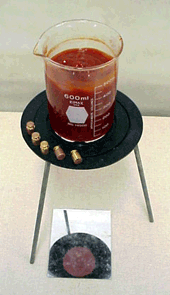Ketchup: Thick Or Thin?
In Drilling Fluid: The Lifeblood of the Well [1] you can read about the interesting properties of Visplex* drilling fluid. This fluid is a liquid while in motion, but when it is at rest it turns into a thick gel. This makes it useful because when the circulation of the drilling fluid stops, the gel suspends the rock cuttings and prevents them from sinking to the bottom of the borehole. Fluids, like Visplex, that become more viscous when standing still, such as Visplex, are called thixotropic.
Ketchup is another thixotropic liquid. Have you ever had trouble getting ketchup to come out of the bottle? You shake and shake but it's stuck. Then, once it gets going it flows quite freely. Ketchup that has been sitting still becomes thick. When it's shaken or stirred it becomes thinner. Here's a way to explore the thixotropic property of ketchup by seeing how rapidly weights fall through it.
 |
Tools and Materials
You will need:
- Beaker full of ketchup at room temperature
- Ring stand
- Mirror
- Several weights or steel balls. We used 10-g (0.35 oz) brass weights that came with our balance scale.
- Spoon
- Stopwatch.
What to Do
- Put the beaker on the ring stand with the mirror underneath as pictured to the right. The mirror lets you more easily see, without twisting your neck, when the weights reach the bottom.
- Drop a weight into the ketchup from just above the surface. Time how long it takes to reach the bottom.
- Drop and time four more weights the same way. Be careful not to drop a weight in the same spot where you previously put one. You want each weight to fall through undisturbed ketchup.
- Retrieve the weights with the spoon.
- Stir the ketchup thoroughly.
- Repeat steps 1 through 3. Use the chart below to record your results.
| Trial | Still ketchup | Stirred ketchup |
|
1 |
|
|
|
2 |
|
|
|
3 |
|
|
|
4 |
|
|
|
5 |
|
|
|
Average |
|
Look at your results. Which is more viscous (thicker), still ketchup or stirred ketchup?
What are some good strategies for getting ketchup to flow easily out of the bottle?
You might also want to have a look at our results. [1]
This content has been re-published with permission from SEED. Copyright © 2025 Schlumberger Excellence in Education Development (SEED), Inc.
Course:
- Science [4]
